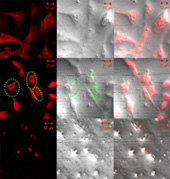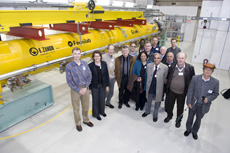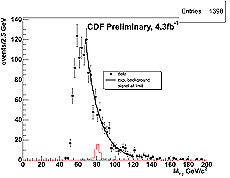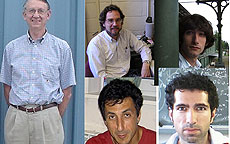|
Have a safe day!
Thursday, Nov. 5
1:30 p.m.
Special Particle Astrophysics Seminar - One West
Speaker: Daniel Grin, California Institute of Technology
Title: Cosmological Hydrogen Recombination: The Effect of High-n States and Forbidden Transitions
2:30 p.m.
Theoretical Physics Seminar - Curia II
Speaker: Peter Graham, Stanford University
Title: A Domino Theory of Flavor
3:30 p.m.
DIRECTOR'S COFFEE BREAK - 2nd Flr X-Over
THERE WILL BE NO ACCELERATOR PHYSICS AND TECHNOLOGY SEMINAR TODAY
Friday, Nov. 6
3:30 p.m.
DIRECTOR'S COFFEE BREAK - 2nd Flr X-Over
4 p.m.
Joint Experimental-Theoretical Physics Seminar - One West
Speaker: Zack Sullivan, Illinois Institute of Technology
Title: Dilepton and Trilepton Production: Standard Model Sources and Beyond
Click here for NALCAL,
a weekly calendar with links to additional information.
|
|
Thursday, Nov. 5
- Apple sticks
- Southwestern chicken tortilla
- Philly-style cheese steak
- Garlic herb-roasted pork
- Mardi Gras jambalaya
- Southwestern turkey wrap
- Assorted slices of pizza
- Marinated grilled chicken Caesar salads
Wilson Hall Cafe Menu |
|
Thursday, Nov. 5
Dinner
- Red pepper soufflé with julienne of zucchini
- Lobster tail with drawn butter
- Spaghetti squash with scallions
- Steamed green beans with dill
- Crème brûlée
Wednesday, Nov. 11
Lunch
- Chicken Marsala
- Angel hair pasta
- Carrots with garlic and rosemary
- Cassata
Chez Leon Menu
Call x3524 to make your reservation.
|
|
|
Tiny particles have big potential, speaker says
 |
| This sequence of images demonstrates how nanoparticles linked to antibodies induced cell death in cancerous cells when researchers applied a light source. From the top row: cancer cells after no light, damaged cells 30 minutes after light and cell death 90 minutes after light. Image credit: Nanobio Interface Group at the Center for Nanoscale Materials (E. Rozhkova and I. Ulasov) |
The small science of nanotechnology could make big changes in energy and medicine yet it is nanotechnology's potential in something even smaller - particle physics - that appeals to one Fermilab scientist.
Although nanotechnology has no direct application to particle physics, Technical Division's Emanuela Barzi said she wouldn't be surprised if Fermilab eventually used nanotechnology. She recently hosted a colloquium talk by Tijana Rajh, a scientist at the Center for Nanoscale Materials at Argonne National Laboratory.
"Because nanotechnology is such a young field and it's making such fast progress, my take on it is that it's very possible that we would be able to find applications in what we do at the laboratory," Barzi said.
Rajh, who spoke on Oct. 14 in a general talk about advances in nanoscience, said scientists are entering a period of rapid advancement in nanotechnology.
"We are at the beginning of the threshold into big discoveries," Rajh said.
Nanotechnology studies the behavior and applications of particles between 1 and 100 nanometers, a scale where ordinary materials exhibit novel properties and experience changes in optical, electrical and magnetic behavior.
Because of nanoparticles' size and ability to couple with biomolecules, scientists hope that the particles could target specific cells and find possible medical applications. By binding nanoscale titanium dioxide to a natural protein that recognizes unhealthy cells, scientists could target only these cells for therapy.
Scientists have found that by layering lattices into multijunction solar cells, they can triple the efficiency of conventional solar technology, but at a cost of $75,000 per square meter. Rajh said that by using nanotechnology, scientists could heat up nanoparticle assemblies that will bring them closer to nanoparticle superlattices, which could be more efficient and cost-effective than conventional manufacturing.
After the talk, Barzi was enthusiastic about nanotechnology's potential. She said she's discussed with Rajh about organizing a small working group at Argonne to look into the technology's applications in superconductor material.
— Chris Knight
|
Fred Garbo Inflatable Theater Company performs Nov. 7
Merging dance, theater and inflatable blobs of parachute silk, the Fred Garbo Inflatable Theater Co., which performs Nov. 7 at Fermilab, is a performance that is fun for all ages.
The show's two performers roll, glide and bobble on stage as their inflatable contraptions morph into cubes, spheres, cylinders and other shapes, all set to music. The show is fast-paced, energetic and filled with comedy, and was a hit on Broadway where the New York Times called it "helium light and hilarious."
Fred Garbo performed on "Sesame Street" as Barkley the Dog and was chief juggler in "Barnum on Broadway"
before beginning the theater company. Daielma Santos trained as a ballerina.
Fermilab's Jerry Zimmerman will perform as Mr. Freeze at a special pre-concert science demonstration beginning at 6 p.m.
The Fermilab Arts Series performance will take place at 7 p.m. in Ramsey Auditorium. Tickets are $26 for adults and $13 for ages 18 and under.
For more information, click here.
|
IUPAP visits Fermilab
 |
In October, Fermilab's Patricia McBride hosted elected officials of the International Union of Pure and Applied Physics attending a meeting in Chicago. At present IUPAP has 20 commissions. McBride is IUPAP vice president and IUPAP commission chair for the Commission on Particles and Fields (C11). On Oct. 22, the day before the start of the meeting, 11 IUPAP council and commission representatives came to Fermilab for an all-day tour, which included a look at the New Muon Lab test facility for SRF cavities.
Front row (from left):
Sergei Nagaitsev (SRF project manager), Patricia McBride (chair C11), Burkhard Fricke (chair C15), Klaus von Klitzing (chair C8), Pratibha Jolly (chair C14), Suresh C Tonwar (chair C4), Alexander Kaminskii (vice president), Sukekatsu Ushioda (president); middle row (from left): Mustansir Barma (vice president), Ari Friberg (past chair AC1), Alan Astbury (past president), Samir Gerges (chair AC3/ICA); back row (from left): Rudzani Nemutudi (associate secretary general), Kurt Riesselmann (Fermilab Office of
Communication) and Jerry Leibfritz (SRF project engineer). |
|
Dark-matter test faces obstacles
From Nature, Nov. 3, 2009
A group of scientists is hoping to replicate a controversial Italian experiment that claims to have detected dark matter. But they might have to do so without the help, or the equipment, of the original group.
Dark matter is thought to make up around 85% of the matter in the Universe, but it rarely interacts with regular matter except through the force of gravity. Researchers working on the DAMA experiment at the Gran Sasso National Laboratory near L'Aquila, Italy, claim they have spotted direct signs of it.
Read more |
|
|
Rare W decay proves too elusive
 |
The invariant mass distribution of the pion and photon for selected events with expected background (black) and signal normalized to the limit value (red). |
The Fermilab Tevatron is the most prolific man-made source of W bosons.
The Tevatron has already produced hundreds of millions of these particles during Run II. The W boson is a heavy, charged mediator of the weak interaction. It is produced when a quark and an antiquark collide at high energies and only exists for less than a trillionth of a trillionth of a second before it decays into lighter particles.
Much of what scientists understand about the electroweak theory (the theory that describes both the electromagnetic force and the weakforce) comes from their measurements of the W boson's properties and decays.
However, scientists have yet to observe a number of rare decay channels.
Using all the data collected by CDF over the past five years, scientists recently probed one of these unobserved channels. They searched for an extremely rare process where the W decays into a charged pion and a photon. Since they were not able to see signs of the decay in the data, CDF scientists determined that the decay must be at least 16,000 times smaller than the rate of the decay to an electron and neutrino. This is the most sensitive limit in the world on this W decay by more than an order of magnitude.
Measuring this decay probes the process of pion formation at high energies and tests our knowledge of the interaction of the W boson and the photon. It also demonstrates that the Tevatron has entered a regime of electroweak precision tests that was previously only available at the LEP collider.
Read more
— Edited by Craig Group
 |
The CDF scientists who made this measurement clockwise, from left: Al Goshaw, Duke University; Thomas Phillips, Duke University; Chris Lester, University of Pennsylvania; Andrea Bocci, Duke; Pavel Murat, Fermilab. |
|
Update to client needed for KCA certificates
 |
| If you see this error message, you may need to update the client you use to obtain your KCA certificate. |
If you use a desktop or laptop computer at Fermilab, you may need to update the client you use to obtain your certificate by Thursday, Nov. 12.
Instructions for updating your client are located here.
Windows computers use a certificate client called NetID Manager to obtain a Kerberos Certificate Authority, or KCA, certificate. Mac and Linux computers use a client called Get Cert.
If you receive automatic security updates - such as patches - on your computer, your client automatically will receive the necessary update, and you will not need to take any action.
Mac users and users with personally managed computers should update their clients manually by following the instructions here, contacting the Service Desk at x2345 or opening a Service Desk ticket for assistance.
On Monday, Nov. 16, NetID Manager and Get Cert will automatically begin requesting certificates from a new server. The server is the device that looks at whether you have signed in with your Kerberos password and decides whether to grant your computer a certificate that will let other sites and programs know who you are. If your client is not prepared to work with the new server, it will not obtain a certificate, and you may lose access to sites and programs you need.
If you are unsure if you need a KCA Certificate, check here for more information. Please call the Service Desk at x2345 with questions.
|
|